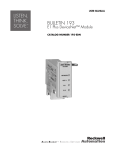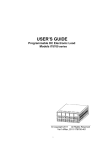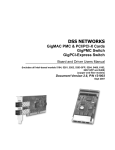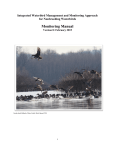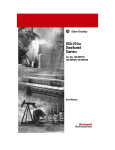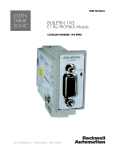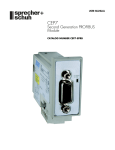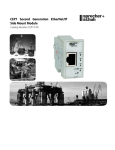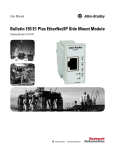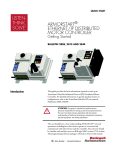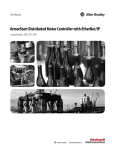Download E3 and E3 Plus Solid-State Overload Relay
Transcript
QUICK STA E3 and E3 Plus Solid-State Overload Relay Quick Start Guide (Bulletins 193 and 592) 2 ATTENTION ! This guide does not replace the User Manual, publication 193-UM002_-EN-P, and is intended for qualified service personnel responsible for setting up and servicing these devices. You must have previous experience with and a basic understanding of electrical terminology, configuration procedures, required equipment, and safety precautions. The user manual can be downloaded from http:// literature.rockwellautomation.com. Important User Information Because of the variety of uses for the products described in this publication, those responsible for the application and use of this control equipment must satisfy themselves that all necessary steps have been taken to assure that each application and use meets all performance and safety requirements, including any applicable laws, regulations, codes, and standards. The illustrations, charts, sample programs and layout examples shown in this guide are intended solely for purposes of example. Since there are many variables and requirements associated with any particular installation, Rockwell Automation does not assume responsibility or liability (to include intellectual property liability) for actual use based upon the examples shown in this publication. Rockwell Automation publication SGI-1.1, Safety Guidelines for the Application, Installation and Maintenance of Solid-State Control (available from your local Allen-Bradley distributor), describes some important differences between solid-state equipment and electromechanical devices that should be taken into consideration when applying products such as those described in this publication. Reproduction of the contents of this copyrighted publication, in whole or part, without written permission of Rockwell Automation, is prohibited. Publication 193-QR003B-EN-P - October 2009 3 General Precautions In addition to the specific precautions listed throughout this manual, the following general statements must be observed. IMPORTANT IMPORTANT IMPORTANT IMPORTANT The purpose of this publication is to serve as a guide for proper installation. The National Electrical Code and any other governing regional or local code overrules the information in this publication.A hazard of personal injury/equipment damage exists if codes are ignored during installation. Rockwell Automation cannot assume responsibility for the compliance or proper installation of the E3 Overload Relay or associated equipment. Only personnel familiar with the E3 Overload Relay and associated machinery should plan to install, start up, and maintain the system. Failure to comply may result in personal injury/equipment damage. An incorrectly applied or installed E3 Overload Relay can result in damage to the components or reduction in product life. Wiring or application errors, such as incorrectly configuring the FLA Setting, supplying incorrect or inadequate DeviceNet supply voltage, connecting an external supply voltage to the input or thermistor terminals, or operating/storing in excessive ambient temperatures may result in malfunction of the E3 Overload Relay. The E3 Overload Relay contains ESD (electrostatic discharge) sensitive parts and assemblies. Static control precautions are required when installing, testing, servicing, or repairing this assembly. Component damage may result if ESD control procedures are not followed. If you are not familiar with static control procedures, refer to Allen-Bradley publication 8200-4.5.2, Guarding Against Electrostatic Damage, or any other applicable ESD protection handbook. Publication 193-QR003B-EN-P - October 2009 4 Introduction Follow these steps to successfully commission the E3 Overload Relay: Table 1: Commissioning Procedure Step Description 1 Hardware Installation 2 Wiring Installation – Typical Motor Connections – External Current Transformer Applications (193-EC_ZZ or 592-EC_ZZ) – External Ground Fault Sensor Applications (193-EC3_ _ , 592-EC3_ _ and 193-EC5_ _ , 592-EC5_ _) 3 DeviceNet Commissioning 4 Setup Requirements Setup for Bulletin 193 or 592-EC1/EC2/EC3/EC5 Overload Relay – Protective Trip and Warning Summaries – Parameter Group Listing Setup for Cat. No. 193-EC4 Current Monitor Relay – Trip and Warning Summaries – Parameter Group Listing Publication 193-QR003B-EN-P - October 2009 5 Hardware Installation The following figures illustrate the starter assembly instructions. Starter Assembly Instructions Figure 1: 100-C09…C43 Starter Assembly Instructions (for use with Cat. Nos. 193-EC_ _B and -EC_ _D) 2 /tN 22 lb-in. 1 3 CLICK Publication 193-QR003B-EN-P - October 2009 6 Figure 2: 100-C60…C85 Starter Assembly Instructions (for use with Cat. No. 193-EC_ _E). 1 2 /tN 35 lb-in. Publication 193-QR003B-EN-P - October 2009 7 Figure 3: 100-D95...D860 Starter Assembly Instructions (for use with Cat. Nos. 193-EC_ _F, 193-EC_ _G, and 193-EC_ _H). Publication 193-QR003B-EN-P - October 2009 8 Wiring Installation Typical Motor Connections Refer to the product nameplate or user manual for power lug termination information including: • Terminal wire size and torque specifications • Maximum wire lengths • Lug kit catalog numbers (108…1250 A) For reliable input signal processing, input wiring should be routed in raceways separate from power cabling. Terminal Designations Figure 4: E3 and E3 Plus Feature Overview LED Status Indicators E3 PLUS Test/Reset Button Node Address Switches (Series B and later) Voltage Input Module Connection (193/592 EC5 only) Ground Fault Sensor Input DeviceNet Port Output and PTC Terminals Input Terminals Publication 193-QR003B-EN-P - October 2009 9 Control Terminals The following table defines the E3 Overload Relay control terminal designations. Table 2: Control Terminal Designation Terminal Designation Reference Description 1 IN 1 General-purpose sinking input number 1 2 IN 2 General-purpose sinking input number 2 3 IN 3 General-purpose sinking input number 3 ➊➋ 4 IN 4 General-purpose sinking input number 4 ➊➋ 5 V+ 6 V+ 7 IN 5 General-purpose sinking input number 5 ➋ 8 IN 6 General-purpose sinking input number 6 ➋ End Earth Ground ➌ +24V DC supply for inputs 13/14 OUT A Output A 23/24 OUT B Output B ➊➋ 95/96 Trip Relay Trip Relay IT1/IT2 PTC Thermistor (PTC) input ➊➍ S1/S2 — External ground fault sensor input ➋➎ ➊ Features are available only with the E3 Plus Overload Relay (cat. nos. 193/592-EC2and 193/592-EC3). ➋ Available only on cat. nos. 193/592-EC5_ _. ➌ An earth ground connection to this terminal will assist in obtaining compliance with electromagnetic compatibility requirements. ➍ The use of shielded cable is recommended for the positive PTC thermistor circuit to assist in obtaining compliance with electromagnetic compatibility requirements. ➎ Available only on cat. nos. 193/592-EC3_ _ and 193/592-EC4_ _. DeviceNet Terminals The following table defines the DeviceNet connector terminal designations. Table 3: DeviceNet Terminal Designation Terminal Signal Function Color 1 V- Common Black 2 CAN_L Signal Low Blue 3 Drain Shield Non-insulated 4 CAN_H Signal High White 5 V+ Power Supply Red Publication 193-QR003B-EN-P - October 2009 10 Grounding The following grounding recommendations are provided to ensure electromagnetic compatibility compliance during installation: • The earth ground terminal of the E3 Overload Relay shall be connected to a solid earth ground via a low-impedance connection • Installations employing an external ground fault sensor shall ground the cable shield at the sensor with no connection made at the E3 Plus Overload Relay • The PTC thermistor cable shield shall be grounded at the E3 Plus Overload Relay with no connection made at the opposite end Wiring Diagrams ATTENTION ! When working on energized circuits, do not rely on the voltage and current information provided by the E3 and E3 Plus for personal safety. Always use a portable voltage or current measurement device and measure the signal locally. Figure 5: Three-Phase D.O.L & Single-Phase Wiring Diagrams Three-Phase Direct-On-Line Wiring Diagram Single-Phase Full-Voltage Wiring Diagram S.C.P.D. L2 L1 L1 L2 L3 LLL 222 LL 111 LL 33 L3 L1 E3/E3Plus Voltage Input Module (For 193/592-EC5 only) 2/T1 4/T2 E3/E3Plus E3/E3Plus 6/T3 /T 22 4/T2 44 /T T1 T2 T1 2 /T /T 11 22/T1 T2 T3 M Publication 193-QR003B-EN-P - October 2009 M L2 Voltage Input Module /T 33 6/T3 66 /T (For 193/592-EC5 only) 11 IMPORTANT IMPORTANT Parameter 27, Single/Three Ph, should be set to single-phase for single-phase devices and three-phase for three-phase devices. In single-phase devices, traditional single-phase wiring (connecting T2 to L3) will result in a vector imbalance of current flowing through the E3 Plus Overload Relay. This will result in inaccurate ground fault reporting and protection. External Current Transformer Application (Cat. No. 193-EC_ZZ) E3 and E3 Plus Overload Relays (Cat. No. 193-EC_ZZ) are designed for use with separately mounted, customer-supplied current transformers (CTs) as required in higher-current applications. The FLA setting range is 9…5000 A for these units, with a legal setting range per the user’s manual. Parameter 78, CT Ratio, is provided for setting the current transformer ratio to be installed. Current Transformer Specifications The 193-EC_ZZ Overload Relays are intended for use with a CT having a secondary current rating of 5 A. The installer shall provide one CT for each motor phase and shall connect the CT secondary leads to the appropriate E3 Overload Relay power terminals as shown in Figure 7: on page 13. The CT shall have an appropriate ratio rating as detailed in the user’s manual. Additionally, the CT shall be selected to be capable of providing the required VA to the secondary load, which includes the E3 Overload Relay burden of 0.1 VA at the rated secondary current and the wiring burden. Finally, the CT shall be rated for protective relaying to accommodate the high inrush currents associated with motor startup and shall have an accuracy of ≤±2% over its normal operating range. ANSI (USA) Class C5 B0.1 CSA (Canada) Class 10L5 IEC (Europe) 5 VA Class 5P10 IMPORTANT The improper selection of a current transformer can result in the E3 Overload Relay reporting inaccurate motor operational data and possible motor damage. The selected current transformer must be rated for protective relaying applications. Publication 193-QR003B-EN-P - October 2009 12 Installation Instructions Cat. No. 193-EC_ZZ Overload Relays are designed to be installed in cat. no. 193-ECPM2 panel mount adapters and connected to separately mounted current transformers. For a panel mount adapter assembly, refer to the instructions included with the panel mount adapter. The E3 Overload Relay must be mounted a distance equal to, or greater than, six times the cable diameter (including insulation) from the nearest current-carrying conductor or current transformer. For applications employing multiple conductors per phase, the diameter of each cable should be added and multiplied by six to determine the proper placement distance for the E3 Overload Relay. Figure 6: Cat. No. 193-EC_ZZ Overload Relay Mounting Placement Primary Current Transformers 6x E3 Overload Relay OR 6x IMPORTANT Placement of the E3 Overload Relay closer than the recommended distance of six times the cable diameter may compromise its current reporting and protection capabilities. Publication 193-QR003B-EN-P - October 2009 13 Figure 7: External CT Connection Diagrams IEC L1 L2 NEMA L3 L1 L2 L3 K1 L L1/1 L2/3 L3/5 E3 Primary Current Transformers T1/2 T2/4 T3/6 T L1/1 L2/3 L3/5 E3 Primary Current Transformers T1/2 T2/4 T3/6 T1 M T2 T3 M External Potential (Voltage) Transformer Application (Cat. No. 193/592-EC5_ _) The E3 Plus Overload Relay Catalog Number 193/592-EC5_ _ can be used with external step-down potential transformers (PTs). The PT ratio is programmed into the E3 Plus by entering the primary winding rating into Parameter 289, PT Pri, and the secondary winding rating into Parameter 290, PT Sec. The voltage mode is also programmed into the E3 Plus by selecting the appropriate mode in Parameter 156, Volt Mode. The E3 Plus will support Wye, Delta, and Open Delta voltage modes with potential transformers. Publication 193-QR003B-EN-P - October 2009 14 Figure 8: External PT Connection Diagrams Line L1 L2 L3 N/GND L1 L2 L3 Wye Connection with PTs Load Line L1 L2 L3 L1 L2 L3 L2 L3 Delta Connection with PTs Load Line L1 L2 L3 L1 Open Delta Connection with PTs Load Publication 193-QR003B-EN-P - October 2009 15 External Ground Fault Sensor Application (Cat. Nos. 193/592-EC3_ _, 193/592-EC4_ _, and 193/592-EC5_ _) Cat. Nos. 193/592-EC3_ _, 193/592-EC4_ _, and 193/592-EC5_ _ E3 Plus Overload Relays are intended to provide ground fault protection when used with the cat. no. 193-CBCT_ external ground fault (core balance) sensor. The ground fault sensor mounts separately from the E3 Plus Overload Relay and must be placed within three meters of the relay. The customer-supplied cable for wiring the ground fault sensor to the E3 Plus Overload Relay should meet the specifications outlined in Table 1.9 on page 15. Table 1.9 Ground Fault Sensor Terminals (S1 and S2) Wire type Shielded, twisted pair Cross section 0.2…4.0 mm2 (#24…12 AWG) Torque 0.55 N•m (5 lb-in.) Power Cable Installation Instructions 1. All power cables (including the neutral when used) must pass through the sensor window. The equipment ground conductor (the conductor used to carry the non-current-carrying metal parts of equipment, as defined by Article 100 of the NEC), must not pass through the sensor window. 2. The power cables through the sensor window should be straight, tightly bundled, centered in the window, and perpendicular to the sensor for a length equal to, or greater than, six times the cable diameter (including insulation) from the sensor. 3. All other conductors with available currents in excess of 1,000 A should be placed a distance equal to, or greater than, six times the cable diameter (including insulation) from the sensor. 4. The power cables of the branch circuit to be protected by the E3 Plus Overload Relay must not be grounded on the load side of the ground fault sensor. 5. If the power cables are enclosed in a conducting jacket, the jacket must be grounded on the line side of the sensor. The jacket must not pass through the sensor window, but must be cut at the window and joined with a conductor that passes outside the sensor window. 6. The power system may be solidly grounded or grounded through an impedance at its source as long as the impedance allows a magnitude of fault current to flow that is within the 1…5 A operational range of the E3 Plus Overload Relay (193/592-EC2_ _) or the 20 mA…5 A operational range of the E3 Plus Overload Relay (193/ 592-EC3_ _, 193/592-EC4_ _, and 193/592-EC5_ _). Publication 193-QR003B-EN-P - October 2009 16 Figure 10: Ground Fault Sensor Mounting Placement GF Sensor 90˚ Power Cables 6x 6x Figure 11: Power Cable Configuration — Two Cables per Phase L3 1 L2 L1 1 L1 The spacer is a short (approximately 10 times the cable diameter in length) piece of cable with no connections to any terminal. L2 L3 Figure 12: Ground Fault Sensor Wiring to the E3 Plus Overload Relay L1 S1 S2 L2 S1 S2 L3 193-CBCT_ Ground Fault Sensor E3 Plus Overload Relay MOTOR IMPORTANT The shield of the twisted pair cable must be connected to earth ground at the sensor, with no connection made at the E3 Plus Overload Relay. Publication 193-QR003B-EN-P - October 2009 17 DeviceNet Node Commissioning Overview E3 Overload Relays are shipped with a default software node address (MAC ID) setting of 63 and the data rate set to Autobaud. Each device on a DeviceNet network must have a unique node address which can be set to a value from 0…63. Keep in mind, most DeviceNet systems use address 0 for the master device (scanner) and node address 63 should be left vacant for introduction of new slave devices. The node address and data rate for series B or later, E3 Overload Relays can be changed using software or by setting the hardware switches that reside on the front of each unit. While both methods yield the same result, it is good practice to choose one method and deploy it throughout the system. IMPORTANT The following recommendations are intended to ensure a trouble-free startup and operation: 1. Use the node commissioning tool in RSNetWorx or the DeviceNet configuration terminal (cat. no. 193-DNCT) when modifying the E3 node address. Do not use the General tab found in the product window in RSNetWorx. The node commissioning tool ensures the device goes through a hard reset and requires the user to upload the most current parameter information from the device prior to making configuration changes. 2. Ensure you have the most current configuration information prior to saving an RSNetWorx configuration file. 3. If you intend to employ the ADR function of the DeviceNet scanner, ensure the device configuration is as you intend it BEFORE saving it to memory. 4. Be aware the Restore Device Defaults button in RSNetWorx will reset the E3 Overload Relay node address setting to 63. For Series B or later devices, the hardware node address switches take precedence over the software node address setting. Publication 193-QR003B-EN-P - October 2009 18 Figure 13: Node Address Switches Table 2: Node Address Setting Switch Settings Description 0…63 The node address setting is determined by the switch values when set in this range. 64…99 For switch settings in this range, the node address setting is determined by the software setting using the RSNetWorx for DeviceNet configuration tool. 99 Factory default setting. Note: For node address switch values in the range of 0…63, cycle power to the E3 Overload Relay to initialize the new setting. Setup Requirements Setup for Cat. Nos. 193/592-EC1/EC2/EC3/EC5 Overload Relays After the E3 Overload Relay is installed according to the guidelines specified in this manual, apply power to the overload relay’s DeviceNet connector. After applying power, the following sequence should occur: 1. The Trip relay should close 2.35 seconds later and the TRIP/WARN LED will not flash (unless a Non-Volatile Fault previously existed or a fault condition is present). 2. At the same time, the NETWORK STATUS LED should flash green for approximately two seconds, then red for a 1/4 second. If autobaud is enabled and the E3 Overload Relay is connected to an active network, the green LED will continue to flash once the baud rate has been determined. If the E3 Overload Relay is not connected to an active network, the LED will not continue to flash. 3. Once the E3 Overload Relay has been allocated by a master, the NETWORK STATUS LED will turn solid green. After being powered up, use the DeviceNet Configuration Terminal (Cat. No. 193-DNCT) in order to set up the parameters. There are five basic parameters that need to be established before using the protective functions. These parameters are listed under the OVERLOAD SETUP menu and include: Single/Three Phase, Full Load Current (FLA) Setting, Trip Class, Overload/PTC Reset mode, and Overload Reset Level. (Note: You will need to program additional parameters when customer-supplied CTs are used.) Once these parameters are set, the E3 Overload Relay is functional. Use the ADVANCED SETUP menu to set other parameters per the specific application requirements. Publication 193-QR003B-EN-P - October 2009 19 Protective Trip/Warning Summaries & Parameter Group Listing (Cat. Nos. 193/592-EC1/EC2/EC3/EC5) Table 3: Trip Summary Trip Function Overload Trip Enable Factory Default Trip Level Settings Trip Delay Settings Inhibit Time Settings ➊ Range Default Range Default Range Default ➋ ➋ Trip Class 5…30 Trip Class 10 — — Enabled Phase Loss Enabled ➌ ➌ 0.1…25.0 s 1.0 s 0…250 s 0s Ground Fault (193/592-EC2) Disabled Internal 1…5 A 2.5 A 0.0…25.0 s 0.5 s 0…250 s 10 s Ground Fault (193/592-EC3) Disabled External 0.02…5 A ➍ 2.5 A 0.0…25.0 s 0.5 s 0…250 s 10 s Stall Disabled 100…600% ➎ 600% ➎ 0…250 s ➎ 10 s➎ — — Jam Disabled 50…600% 250% 0.1…25.0 s 5.0 s 0…250 s 10 s Underload Disabled 10…100% FLA ➏ 50% 0.1…25.0 s 5.0 s 0…250 s 10 s PTC Disabled — — — — — — Current Imbalance Disabled 10…100% 35% 0.1…25.0 s 5.0 s 0…250 s 10 s Comm Fault Enabled — — — — — — Comm Idle Disabled — — — — — — Remote Trip Disabled Voltage Input Module Hardware Fault ➐ Disabled — — — — — — — — — — — — Undervoltage L-L ➐ Disabled 0...65535 100 0.1…25.0 s 1.0 s 0…250 s 10 s Overvoltage L-L ➐ Disabled 0...65535 500 0.1…25.0 s 1.0 s 0…250 s 10 s Voltage Unbalance ➐ Disabled 0…100 75 0.1…25.0 s 1.0 s 0…250 s 10 s Phase Rotation ➐ Disabled 1…2 1 — — 0…250 s 10 s Under Frequency ➐ Disabled 0…250 57 0.1…25.0 s 1.0 s 0…250 s 10 s Over Frequency ➐ Disabled 0…250 63 0.1…25.0 s 1.0 s 0…250 s 10 s Under Real Power ➐ Disabled 0…32767 0.1…25.0 s 1.0 s 0…250 s 10 s Over Real Power ➐ Disabled 0…32767 0.1…25.0 s 1.0 s 0…250 s 10 s Publication 193-QR003B-EN-P - October 2009 20 Table 3: Trip Summary Trip Function Trip Enable Factory Default Trip Level Settings Range Default Trip Delay Settings Range Default Inhibit Time Settings ➊ Range Default Under Consumed kVAR ➐ Disabled 0…32767 0.1…25.0 s 1.0 s 0…250 s 10 s Over Consumed kVAR ➐ Disabled 0…32767 0.1…25.0 s 1.0 s 0…250 s 10 s Under Generated kVAR ➐ Disabled -32767…0 0.1…25.0 s 1.0 s 0…250 s 10 s Over Generated kVAR ➐ Disabled -32767…0 0.1…25.0 s 1.0 s 0…250 s 10 s Under Power kVA ➐ Disabled 0…32767 0.1…25.0 s 1.0 s 0…250 s 10 s Over Power kVA ➐ Disabled 0…32767 0.1…25.0 s 1.0 s 0…250 s 10 s Under Power Factor Lagging ➐ Disabled -100…0 -90 0.1…25.0 s 1.0 s 0…250 s 10 s Over Power Factor Lagging ➐ Disabled -100…0 -95 0.1…25.0 s 1.0 s 0…250 s 10 s Under Power Factor Leading ➐ Disabled 0...100 90 0.1…25.0 s 1.0 s 0…250 s 10 s Over Power Factor Leading ➐ Disabled 0...100 95 0.1…25.0 s 1.0 s 0…250 s 10 s ➊ The inhibit time setting parameters are applicable to both the trip and warning functions. ➋ FLA Setting range and default values are dependent upon the current rating of the product. See the user manual for more information. ➌ Phase loss trip level is factory-set at a current imbalance greater than or equal to 100% and is not user-adjustable. ➍ Must use Ground Fault Sensors (Cat. No. 193-CBCT_). ➎ Stall protection is only applicable during the motor starting sequence. If any phase of current falls below the programmed Stall Trip Level, stall protection is disabled. ➏ 50…100% for devices with FRN 1.003 and earlier. ➐ Available on 193/592-EC5 only. Publication 193-QR003B-EN-P - October 2009 21 Table 4: Warning Summary Warning Function Warning Enable Factory Default Warning Level Settings Inhibit Time Settings ➊ Range Default Range Default Disabled 0…100%➋ 85% — — — — — — — Ground Fault (193/592-EC2) Disabled Internal 1…5 A 2.0 A 0…250 s 10 s Ground Fault (193/592-EC3) Disabled External 0.02…5 A ➌ 2.0 A 0…250 s 10 s Overload Phase Loss Stall — — — — — Jam Disabled 50…600% 150% 0…250 s 10 s 10 s Underload Disabled 10…100%➍ 70% 0…250 s Thermistor (PTC) Disabled — — — — Current Imbalance Disabled 10…100% 20% 0…250 s 10 s Comm Fault Disabled — — — — Comm Idle Disabled — — — — Voltage Input Module Hardware Fault r Enabled — — — — Under Voltage L-L r Disabled 0...65535 400 0…250 s 10 s Over Voltage L-L ➎ Disabled 0...65535 490 0…250 s 10 s Voltage Unbalance ➎ Disabled 0…100 85 0…250 s 10 s Phase Rotation ➎ Disabled 1…2 1 0…250 s 10 s Under Frequency ➎ Disabled 0…250 58 0…250 s 10 s Over Frequency ➎ Disabled 0…250 62 0…250 s 10 s Under Real Power ➎ Disabled 0…32767 0…250 s 10 s Over Real Power ➎ Disabled 0…32767 0…250 s 10 s Under Consumed kVAR ➎ Disabled 0…32767 0…250 s 10 s Over Consumed kVAR ➎ Disabled 0…32767 0…250 s 10 s Under Generated kVAR ➎ Disabled -32767…0 0…250 s 10 s Over Generated kVAR ➎ Disabled -32767…0 0…250 s 10 s Under Power kVA ➎ Disabled 0…32767 0…250 s 10 s Over Power kVA ➎ Disabled 0…32767 0…250 s 10 s Under Power Factor Lagging ➎ Disabled -100…0 -95 0…250 s 10 s Over Power Factor Lagging ➎ Disabled -100…0 -90 0…250 s 10 s Under Power Factor Leading ➎ Disabled 0...100 95 0…250 s 10 s Over Power Factor Leading ➎ Disabled 0...100 90 0…250 s 10 s ➊ The inhibit time setting parameters are applicable to both the trip and warning functions. ➋ Overload warning setting is entered as a percentage of the thermal capacity utilized. ➌ Must use Ground Fault Sensors (Cat. No. 193-CBCT_). ➍ 50…100% for devices with FRN 1.003 and earlier. ➎ Available on 193/592-EC5 only. Publication 193-QR003B-EN-P - October 2009 22 Table 5: Parameter Group Listing Monitor Params Overload Setup Reset/Lock Advanced Setup DeviceNet Setup Output Setup DeviceLogix 65 OutA Pr FltState 79 Comm Override 1 L1 Current 27 Single/ Three Ph 26 Trip Reset 24 Trip Enable 55 AutoBaudEnable 2 L2 Current 28 FLA Setting 53 Program Lock 25 Warning Enable 56 NonVol Baud Rate 66 OutA Pr FltValue 80 Network Override 81 Net outputs 82 Net Out COS Mask 3 L3 Current 29 Trip Class 54 Set to Defaults 27 Single/Three Ph 58 COS Mask 67 OutA DN FltState 4 Average Current 30 OL/PTC ResetMode 103 Test Enable* 28 FLA Setting 59 Output Assembly 68 OutA DN FltValue 5 L1 % FLA 31 OL Reset Level 29 Trip Class 60 Input Assembly 69 OutA DN IdlState 6 L2 % FLA 78 CT Ratio 30 OL/PTC ResetMode 61 Assy Word0 Param 70 OutA DN IdlValue 7 L3 % FLA 31 OL Reset Level 62 Assy Word1 Param 71 OutB Pr FltState 8 Average % FLA 32 OL Warning Level 63 Assy Word2 Param 72 OutB Pr FltValue 9 % Therm Utilized 33 PL Inhibit Time 64 Assy Word3 Param 73 OutB DN FltState 10 GF Current 34 PL Trip Delay 74 OutB DN FltValue 11 Current Imbal 35 GF Inhibit Time 75 OutB DN IdlState 12 OL Time To Trip 36 GF Trip Delay 76 OutB DN IdlValue 13 OL Time To Reset 37 GF Trip Level 14 Trip Status 38 GF Warn Level 15 Warning Status 39 Stall Enbld Time 16 Trip Log 0 40 Stall Trip Level 17 Trip Log 1 41 Jam Inhibit Time 18 Trip Log 2 42 Jam Trip Delay 19 Trip Log 3 43 Jam Trip Level 20 Trip Log 4 44 Jam Warn Level 21 Device Status 45 UL Inhibit Time 104 Clear Queue* 22 Firmware 46 UL Trip Delay 23 Dev Config 47 UL Trip Level 90 Warn Log 0➊ 48 UL Warn Level 91 Warn Log 1➊ 49 CI Inhibit Time 92 Warn Log 2➊ 50 CI Trip Delay 93 Warn Log 3➊ 51 CI Trip Level 94 Warn Log 4➊ 52 CI Warn Level 95 Elapsed Time➊ 78 CT Ratio 96 Starts Counter➊ 83 IN 1 Assignment 97 Starts Available➊ 84 IN 2 Assignment 98 Time To Start➊ 85 IN 3 Assignment 86 IN 4 Assignment 87 2-Spd Net Enable 88 2-Speed FLA Set 89 GF Trip Inhibit 99 Starts/Hour➊ 100 Starts Interval➊ 101 PM - # Starts➊ 102 PM - Oper. Hours➊ 105 GF Warn Delay➊ 106 GF Sensing Range➊ ➊ Series C (FRN 4.00 and higher) Publication 193-QR003B-EN-P - October 2009 23 Table 6: Parameter Group Listing, Continued Device Logix 79 Comm Override 80 Network Override 81 Net outputs 82 Net Out COS Mask TripWarn History ➋ Trip Snapshot ➋ Voltage Monitor ➌ Power Monitor Voltage Setup ➌ ➌ Power Setup ➌ 132 Trip History 0 144 SS L1 Current 160 V Trip Status 156 Volt Mode 173 L1 Real Power 157 Power Scale 133 Trip History 1 134 Trip History 2 145 SS L2 Current 146 SS L3 Current 161 V Warn Status 162 L1-L2 Voltage 158 V Trip Enable 159 V Warn Enable 174 L2 Real Power 175 L3 Real Power 225 PW Trip Enable 226 PW Warn Enable 135 Trip History 3 136 Trip History 4 137 Warn History 0 138 Warn History 1 139 Warn History 2 140 Warn History 3 141 Warn History 4 142 TripHistory Mask 143 WarnHistory Mask 299 V TripHist Mask 300 V WarnHist Mask 301 PW TripHist Mask 302 PW WarnHist Mask 147 SS %TCU 148 SS GF Current 149 SS L1-L2 Voltage 150 SS L2-L3 Voltage 151 SS L3-L1 Voltage 152 SS Tot Real Pwr 153 SS Tot kVAR 154 SS Tot kVA 155 SS Total PF 163 L2-L3 Voltage 164 L3-L1 Voltage 165 Ave Voltage L-L 166 L1-N Voltage 167 L2-N Voltage 168 L3-N Voltage 169 Ave Voltage L-N 170 Volt Unbalance 171 Volt Frequency 172 V Phase Rot 215 UV Inhibit Time 216 UV Trip Delay 217 UV Trip Level 218 UV Warn Level 219 OV Inhibit Time 220 OV Trip Delay 221 OV Triip Level 222 OV Warn Level 223 Ph Rot Inhib Time 224 Ph Rot Trip 229 V UnhalInhib Time 230 V UnbalTripDelay 231 V UnbalTrip Level 232 V UnbalWarnLevel 233 UF Inhibit Time 234 UF Trip Delay 235 UF Trip Level 236 UF Warn Level 237 OF Inhibit Time 238 OF Trip Delay 239 OF Trip Level 240 OF Warn Level 289 PT Pri 290 PT Sec 176 Total Real Power 177 L1 Reactive Power 178 L2 Reactive Power 179 L3 Reactive Power 180 Tot Reactive Power 181 L1 Apparent Power 182 L2 Apparent Power 183 L3 Apparent Power 184 Tot Apparent Power 185 L1 PF 186 L2 PF 187 L3 PF 188 Total PF 189 kWh 10E6 190 kWh 10E3 191 kWh 10E0 192 kWh 10E-3 193 kVARh Con 10E6 194 kVARh Con 10E3 195 kVARh Con 10E0 196 kVARh Con 10E-3 197 kVARh Gen 10E6 198 kVARh Gen 10E3 199 kVARh Gen 10E0 200 kVARh Gen 10E-3 201 kVARh Net 10E6 202 kVARh Net 10E3 203 kVARh Net 10E0 204 kVARh Net 10E-3 205 kVAh 10E6 206 kVAh 10E3 207 kVAh 10E0 208 kVAh 10E-3 209 kW Demand 210 Max kW Demand 211 VAR Demand 212 Max VAR Demand 213 VA Demand 214 Max VA Demand 227 PW Trip Status 228 PW Warnn Status 241 UW Inhibit Time 242 UW Trip Delay 243 UW Trip Level 244 UW Warn Level 245 OW Inhibit Time 246 OW Trip Delay 247 OW Trip Level 248 OW Warn Level 249 UVARC Inhibit Time 250 UVARC Trip Delay 251 UVARC Trip Level 252 UVARC Warn Level 253 OVARC Inhibit Time 254 OVARC Trip Delay 255 OVARC Trip Level 256 OVARC Warn Level 257 UVARG Inhibit Time 258 UVARG Trip Delay 259 UVARG Trip Level 260 UVARG Warn Level 261 OVARG Inhibit Time 262 OVARG Trip Delay 263 OVARG Trip Level 264 OVARG Warn Level 265 UVA Inhibit Time 266 UVA Trip Delay 267 UVA Trip Level 268 UVA Warn Level 269 OVA Inhibit Time 270 OVA Trip Delay 271 OVA Trip Level 272 OVA Warn Level 273 UPFLG Inhibit Time 274 UPFLG Trip Delay 275 UPFLG Trip Level 276 UPFLG Warn Level 277 OPFLG Inhibit Time 278 OPFLG Trip Delay 279 OPFLG Trip Level 280 OPFLG Warn Level 281 UPFLD Inhibit Time 282 UPFLD Trip Delay 283 UPFLD Trip Level 284 UPFLD Warn Level 285 OPFLD Inhibit Time 286 OPFLD Trip Delay 287 OPFLD Trip Level 288 OPFLD Warn Level 291 Demand Period 292 Num of Periods o Series C (FRN 5.00 and Higher) ➌ 193/592-EC5 Only Publication 193-QR003B-EN-P - October 2009 24 Setup for Cat. No. 193-EC4 Current Monitor Relay After the E3 Plus Current Monitor Relay is installed according to the guidelines specified in this manual, apply power to the relay’s DeviceNet connector. After applying power, the following sequence should occur: 1. The Trip relay should close 2.35 seconds later and the TRIP/WARN LED will not flash (unless a Non-Volatile Fault previously existed or a fault condition is present). 2. At the same time, the NETWORK STATUS LED should flash green for approximately two seconds, then red for a 1/4 second. If autobaud is enabled and the E3 Plus Current Monitor Relay is connected to an active network, the green LED will continue to flash once the baud rate has been determined. If the E3 Plus Current Monitor Relay is not connected to an active network, the LED will not continue to flash. 3. Once the E3 Plus Current Monitor Relay has been allocated by a master, the NETWORK STATUS LED will turn solid green. After being powered up, use the DeviceNet Configuration Terminal (Cat. No. 193-DNCT) in order to set up the parameters. There are six basic parameters that need to be established before using the trip functions. These parameters are listed under the ADVANCED SETUP menu and include: L1 UC Trip Level, L2 UC Trip Level, L3 UC Trip Level, L1 OC Trip Level, L2 OC Trip Level, and L3 OC Trip Level. After the parameters have been configured, enable the specific trip bit as described in Table 7: for Parameter 24 (Trip Enable) to energize the relay when conditions are met. Once these parameters are set, the E3 Plus Current Monitor Relay is functional. Use the ADVANCED SETUP menu to set other parameters per the specific application requirements. Publication 193-QR003B-EN-P - October 2009 25 Protective Trip/Warning Summaries & Parameter Group Listing (Cat. No. 193-EC4) Table 7: Trip Summary Trip Function Trip Enable Factory Default Trip Level Settings Trip Delay Settings Inhibit Time Settings Range Default Range Default Range Ground Fault Disabled 0.02…5 A 2.5 A 0.0…25 s 0.5 s 0…250 s 10 s L1 Undercurrent Disabled 0.2…45 A — 0.1…25 s 1.0 s 0…250 s 1.0 s L2 Undercurrent Disabled 0.2…45 A — 0.1…25 s 1.0 s 0…250 s 1.0 s L3 Undercurrent Disabled 0.2…45 A — 0.1…25 s 1.0 s 0…250 s 1.0 s L1 Overcurrent Disabled 0.4…270 A — 0.1…25 s 1.0 s 0…250 s 1.0 s L2 Overcurrent Disabled 0.4…270 A — 0.1…25 s 1.0 s 0…250 s 1.0 s L3 Overcurrent Disabled 0.4…270 A — 0.1…25 s 1.0 s 0…250 s 1.0 s L1 Loss Disabled — — 0.5…25 s 0.5 s 0…250 s 1.0 s L2 Loss Disabled — — 0.5…25 s 0.5 s 0…250 s 1.0 s L3 Loss Disabled — — 0.5…25 s 0.5 s 0…250 s 1.0 s Comm Fault Disabled — — — — — — Comm Idle Disabled — — — — — — Remote Trip Disabled — — — — — — Default Publication 193-QR003B-EN-P - October 2009 26 Table 8: Warning Summary Warning Function Warning Enable Factory Default Range Default Range Default Range Ground Fault Disabled 0.02…5 A 2.0 A 0.0…25 s 0.0 s 0…250 s 10 s L1 Undercurrent Disabled 0.2…45 A — — — 0…250 s 1.0 s L2 Undercurrent Disabled 0.2…45 A — — — 0…250 s 1.0 s L3 Undercurrent Disabled 0.2…45 A — — — 0…250 s 1.0 s L1 Overcurrent Disabled 0.4…270 A — — — 0…250 s 1.0 s L2 Overcurrent Disabled 0.4…270 A — — — 0…250 s 1.0 s L3 Overcurrent Disabled 0.4…270 A — — — 0…250 s 1.0 s L1 Loss Disabled — — — — 0…250 s 1.0 s L2 Loss Disabled — — — — 0…250 s 1.0 s L3 Loss Disabled — — — — 0…250 s 1.0 s Comm Fault Disabled — — — — — — Comm Idle Disabled — — — — — — Remote Trip Disabled — — — — — — Warning Level Settings Publication 193-QR003B-EN-P - October 2009 Warning Delay Settings Inhibit Time Settings Default 27 Table 9: Parameter Group Listing (Cat. No. 193-EC4) Monitor Params Reset / Lock Advanced Setupt DeviceNet Setup Output Setup DeviceLogix 1 L1 Current 26 Trip Reset 24 Trip Enable 55 AutoBaudEnable 65 OutA Pr FltState 79 Comm Override 2 L2 Current 53 Program Lock 25 Warning Enable 56 NonVol Baud Rate 66 OutA Pr FltValue 80 Network Override 3 L3 Current 54 Set to Defaults 35 GF Inhibit Time 58 COS Mask 67 OutA DN FltState 81 Net Outputs 10 GF Current 103 Test Enable 36 GF Trip Delay 59 Output Assembly 68 OutA DN FltValue 82 Net Out COS Mask 14 Trip Status 104 Clear Queue 37 GF Trip Level 60 Input Assembly 69 OutA DN IdlState 15 Warning Status 38 GF Warn Level 61 Assy Word0 Param 70 OutA DN IdlValue 16 Trip Log 0 83 IN 1 Assignment 62 Assy Word1 Param 71 OutB Pr FltState 17 Trip Log 1 84 IN 2 Assignment 63 Assy Word2 Param 72 OutB Pr FltValue 18 Trip Log 2 85 IN 3 Assignment 64 Assy Word3 Param 73 OutB DN FltState 19 Trip Log 3 86 IN 4 Assignment 74 OutB DN FltValue 20 Trip Log 4 89 GF Trip Inhibit 75 OutB DN IdlState 21 Device Status 101 # of Starts 76 OutB DN IdlValue 22 Firmware 102 Operating Hours 23 Dev Config 105 GF Warn Delay 90 Warn Log 0 106 GF Sensing Range 91 Warn Log 1 107 UC Inhibit Time 92 Warn Log 2 108 L1 UC Trip Level 93 Warn Log 3 109 L1 UC Trip Delay 94 Warn Log 4 110 L1 UC Warn Level 95 Elapsed Time 111 L2 UC Trip Level 96 Starts Counter 112 L2 UC Trip Delay 113 L2 UC Warn Level 114 L3 UC Trip Level 115 L3 UC Trip Delay 116 L3 UC Warn Level 117 OC Inhibit Time 118 L1 OC Trip Level 119 L1 OC Trip Delay 120 L1 OC Warn Level 121 L2 OC Trip Level 122 L2 OC Trip Delay 123 L2 OC Warn Level 124 L3 OC Trip Level 125 L3 OC Trip Delay 126 L3 OC Warn Level 127 LL Inhibit Time 128 L1 Loss Trip Delay 129 L2 Loss Trip Delay 130 L3 Loss Trip Delay Publication 193-QR003B-EN-P - October 2009 28 Table 10: Parameter Group Listing (Cat. No. 193-EC4), Continued TripWarn History ➊ Trip Snapshot ➊ 132 Trip History 0 144 SS L1 Current 133 Trip History 1 145 SS L2 Current 134 Trip History 2 146 SS L3 Current 135 Trip History 3 148 SS GF Current 136 Trip History 4 137 Warn History 0 138 Warn History 1 139 Warn History 2 140 Warn History 3 141 Warn History 4 142 TripHistory Mask 143 WarnHistory Mask ➊ Series C (FRN 5.00 and Higher) Short-Circuit Ratings ATTENTION To prevent electrical shock, disconnect from power source before installing or servicing ! ATTENTION ! Select the motor branch circuit protection that complies with the National Electrical Code and any othergoverning regional and local codes The Bulletin 193/592 E3 Overload relay is suitable for use on circuits capable of delivering not more than the RMS symmetrical amperes listed in the followign tables: Publication 193-QR003B-EN-P - October 2009 29 Table 11: Standard Fault Short-Circuit Ratings per UL 508 and CSA 22.2, No. 14 Cat. No. Max. Available Fault Current [A] 193-EC_B, 592EC_T 5000 193-EC_D, 592EC_C 5000 193-EC_E, 592EC_D 10000 193-EC_F 10000 193-EC_G 18000 193-EC_H 42000 193-EC_Z 5000 Max. Voltage [V] 600 Publication 193-QR003B-EN-P - October 2009 30 Table 12: High Fault Short-Circuit Ratings per UL 508 and CSA 22.2, No. 14 with Bulletin 100-C and 100-D contactors Cat. No. Contactor Max. Available Max. Fault Current Voltage [A] [V] Max. Class J or CC Fuse [A] 100-C09 9 20 100-C12 12 20 100-C16 16 30 100-C23 23 30 100-C30 30 50 100-C37 37 50 100-C43 43 70 100-C60 60 80 100-C72 72 100 100-C85 85 150 FF, ZZ 100-D95 95 200 FF, ZZ 100-D110 110 FF, ZZ 100-D140 140 GF, ZZ 100-D180 180 300 100-D210 210 400 100-D250 250 400 100-D300 300 500 100-D210 210 400 100-D250 250 400 100-D300 300 500 100-D300 300 500 100-D420 420 600 _B _D _E 193-EC1 193-EC2 193-EC3 193-EC4 193-EC5 Max. Starter FLC [A] GG, ZZ HG, ZZ JG, ZZ Publication 193-QR003B-EN-P - October 2009 100000 600 200 250 31 Table 13: High Fault Short-Circuit Ratings per UL 508 and CSA 22.2, No. 14 with NEMA contactors Cat. No. Contactor Size _T 00 Max. Available Max. Fault Current Voltage [A] [V] 100000 _C 0 _C 1 100000 100000 592-EC1 592-EC2 592-EC3 592-EC5 J 600 — 20 — 240 30 30 FDB 3025/ LFB3070R 30 FDB 3025/ LFB3070R 480 _D 3 100000 100000 30 600 30 240 60 480 240 2 Circuit Breaker/ Limiter R 600 _C Max. UL Fuse [A] 30 30 100 30 — 100 FDB 3050/ LFB3035R 50 FDB 3050/ LFB3035R 50 — 200 FDB 3100/ LFB3150R 480 60 100 — 600 60 100 — 240 200 350 FDB 3150/ LFB3150R 480 100 200 FDB 3125/ LFB3150R 600 100 200 FDB 3100/ LFB3150R Table 14: IFC Short-Circuit Ratings per EN60947-4-1 Cat. No. Prospective Short-Circuit Current Ir [A] 193-EC_B, 592EC_T 1000 193-EC_D, 592EC_C 3000 193-EC_E, 592EC_D 5000 193-EC_F 10000 193-EC_G 18000 193-EC_H 30000 193-EC_Z 1000 Conditional Short-Circuit Current Iq [A] 100000 Max. Voltage [V] 690 Publication 193-QR003B-EN-P - October 2009 32 Fuse Coordination Table 15: IEC Type 1 and Type II Fuse Coordination with Bulletin 100-C and 100-D Contactors per EN60947-4-1 Cat. No. Contactor Max. Starter FLC [A] 100-C09 9 100-C12 12 100-C16 16 100-C23 23 40 40 100-C30 30 50 50 100-C37 37 50 50 100-C43 43 70 70 100-C60 60 80 80 100-C72 72 100 100 100-C85 85 150 150 FF, ZZ 100-D95 95 FF, ZZ 100-D110 110 _B _D _E 193-EC1 193-EC2 193-EC3 193-EC4 193-EC5 Prospective Conditional Max. Type I Type II Short-Circuit Short-Circuit Voltage with Class with Current Ir [A] Current Iq [A] [V] J Fuse [A] Class J Fuse [A] 1000 3000 5000 100000 600 20 15 20 20 30 30 200 200 200 200 FF, ZZ 100-D140 140 250 250 GF, ZZ 100-D180 180 300 300 100-D210 210 400 400 GG, ZZ 100-D250 250 400 400 100-D300 300 500 500 100-D210 210 400 400 HG, ZZ 100-D250 250 400 400 100-D300 300 500 500 100-D300 300 500 500 100-D420 420 600 600 JG, ZZ 10000 Publication 193-QR003B-EN-P - October 2009 33 Table 16: Type 1 and Type II Fuse Coordination with NEMA Contactors Cat. No. Contactor Max. Size Starter FLC [A] Prospective Short-Circuit Current Ir [A] Conditional Short-Circuit Current Iq [A] Max. Type I with Type II Voltage Class J with Class [V] Fuse [A] J Fuse [A] 592-EC_T 00 9 1000 20 592-EC_C 0, 1 18, 27 3000 30 30 592-EC_C 2 45 3000 60 60 592-EC_D 3 90 5000 200 200 100000 600 20 Publication 193-QR003B-EN-P - October 2009 Publication 193-QR003B-EN-P - October 2009 PN-37176 Supercedes publication 193-QR003A-EN-P - January 2008 Copyright ©2009 Rockwell Automation, Inc. All Rights Reserved. Printed in USA


































